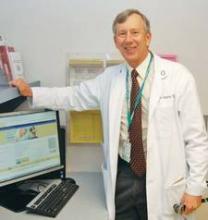Talking warfarin with patients? Keep it simple
The core skills of communication and patient education emerge front and center in the treatment of patients who take anticoagulants. Even long-term users of warfarin often lack the understanding it takes to avoid adverse events and readmissions, according to a recent study.
Clinicians and medical centers are responding to this problem armed with both data and individual experience.
At the University of California, Davis Medical Center, Dr. Richard White described a scenario: He sits down with a patient and starts to explain the side effects of taking warfarin, or Coumadin under its brand name. He looks at the patient and says, "I want you to understand that on this medication, Coumadin, there can be a lot of interactions with other medicines."
The reaction: a blank stare.
For about one-third of patients, it’s the moment there’s a communication disconnect, said Dr. White, medical director of the UC Davis Anticoagulation Service. "The word interaction, they sometimes don’t understand it. They just immediately get lost." The solution: Rephrase and communicate in clear, simple language.
"We’re worried how Coumadin mixes with any new medication. If you start a new medication, call us," explained Dr. White. Also, patient education with easy-to-understand language is extremely important for this commonly prescribed drug with its well-known trifecta of trip wires: It requires careful blood monitoring, has a strict dosing regimen, and can lead to potentially dangerous drug and food interactions. A survey of 184 long-term warfarin patients of the UC Davis Medical Center’s anticoagulation clinic found that the majority of participants had trouble recognizing high-risk situations that compromised patient safety. (See related story.)
The survey, reported in the January 2013 issue of the Joint Commission Journal on Quality and Patient Safety, found that more than 50% of respondents categorized acute chest pain and taking the wrong dosage as among "urgent" situations, while a significant percentage failed to recognize the urgency of other high-risk scenarios like stroke symptoms that include a loss of vision and risk of bleeding after incidental head trauma. The Joint Commission concluded that patient-centered strategies are needed to teach the difference between high- and low-risk situations related to warfarin, attributed to an estimated 29,000 emergency department visits annually and one out of every seven adverse drug events (Jt. Comm. J. Qual. Patient Saf. 2013;39:22-31).
Speak plainly, not pharmacologically
Miscommunication is a leading cause of medical errors with this drug, according to Dr. Kathryn Hassell, professor of medicine in the division of hematology at the University of Colorado, Denver, and head of the anticoagulation monitoring clinic at the University of Colorado Hospital.
To help patients discern high-risk from low-risk situations, experts say it’s best to present patients with "real-life" scenarios and ask for feedback to gauge level of understanding.
"Rather than the doctors teaching the patients about the pharmacology of Coumadin, we create a list of potential events and teach people how to be prepared for that event," said Dr. White, coauthor of the Joint Commission article. He advises fellow physicians to think about possible events that would make the doctor, pharmacist, or patient "very concerned." Then, ask patients a series of questions, like: What should you do if you forget to take your medication or accidentally take too much? What should you do if you suddenly see bruising? What should you do if your bowel movements suddenly turn black? If you suddenly develop a nosebleed, what should you do?
And follow up with clear instructions.
"If you get a nosebleed or cut yourself, you apply pressure for 5 to 10 minutes, and if you continue to bleed, call us in the clinic or go to the emergency room," Dr. White explained. "They don’t know how long to apply pressure or that if you apply pressure, it may stop. These are the kinds of situations that a patient experiences, and they may not be educated at all about what to do."
Similarly, Dr. Hassell lays out scenarios for her patients skilled at skiing and other physical activities, which are possible on warfarin. She doesn’t advise them to ditch their active lifestyle, but to use good judgment, because there may be risks and greater consequences when patients are on anticoagulation therapy. For example, she’d ask a downhill skier about his crash history and resulting injuries. To "a guy who says, ‘I’ve busted everything every time I’ve gone, and had to get blood transfusions’ when not on Coumadin," she would ask: "Okay, really, do you want to put yourself in that place?"








